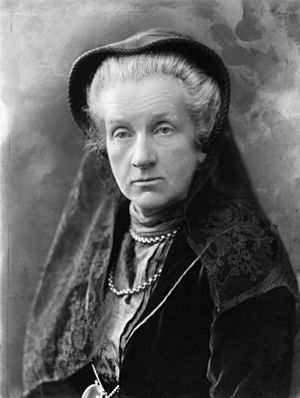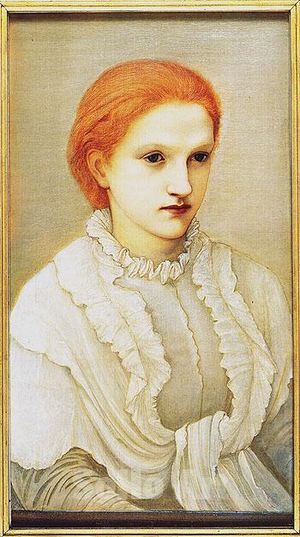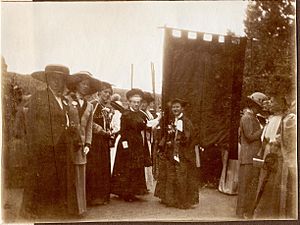Lady Frances Balfour facts for kids
Quick facts for kids
Lady Frances Balfour
|
|
|---|---|

Balfour in 1919
|
|
| Born |
Frances Campbell
22 February 1858 London, UK
|
| Died | 25 February 1931 (aged 73) London, UK
|
| Nationality | British |
| Known for | women's rights activism and authorship |
| Political party |
|
| Spouse(s) | Eustace Balfour (d. 1911) |
| Children | 5 |
| Parent(s) | George Campbell, 8th Duke of Argyll Lady Elizabeth Sutherland-Leveson-Gower |

Lady Frances Balfour (born Frances Campbell; 1858–1931) was an important British lady, writer, and activist. She played a big role in the fight for women's right to vote in the United Kingdom. Frances Balfour was a leader in the National Society for Women's Suffrage from 1896 to 1919. She believed in peaceful ways to achieve change. She did not support the more aggressive actions of the group called the suffragettes.
Contents
Early Life and Family
Frances was born in London on February 22, 1858. She was the tenth child of George Campbell, 8th Duke of Argyll. He was a Scottish nobleman and a politician from the Liberal Party. Her mother was Lady Elizabeth Sutherland-Leveson-Gower.
From a young age, Frances had a hip disease. This caused her constant pain and made her walk with a limp. Her parents were very religious. They were involved in many campaigns to improve society. As a child, Frances helped with these efforts. For example, she knitted clothes for children whose parents used to be slaves. This was after slavery was officially banned in British territories in 1833.
In 1879, Frances married Eustace Balfour. He was an architect from Scotland who lived in London. Eustace's uncle, Lord Salisbury, was the Prime Minister of Britain three times. Eustace's older brother, Arthur Balfour, also became a British Prime Minister. He was a member of the Conservative Party.
However, Frances did not agree with her in-laws' Conservative politics. She and her parents supported William Gladstone. He was a famous Liberal statesman. Lady Frances Balfour and her husband had different political views. Because of this, they spent less and less time together.
Fighting for Women's Right to Vote

Lady Frances Balfour was the only member of the British upper class to lead the campaign for women's right to vote. She started her work for women's suffrage in 1889. She became the main link between the peaceful activists and the British Parliament.
In 1897, she joined the executive committee of the National Union of Women's Suffrage Societies (NUWSS). Millicent Garrett Fawcett was the president of this group. Frances served on this committee until some women gained the right to vote in 1918. She was also the president of the London Society of Women's Suffrage. This was the largest group fighting for votes for women in Britain. She held this role from 1896 to 1919.
Frances also led the Lyceum Club from 1903 to 1915. This club offered services to women who worked in professions. After her work for women's votes was almost done, Frances joined the National Council of Women of Great Britain in 1917. She served as its president from 1921 to 1923.
Lady Frances wrote six books. One of them was her autobiography, Ne Obliviscaris (Dinna Forget). She also helped edit a magazine called Women and Progress with Nora Vynne. This magazine worked to achieve equal rights for men and women. They believed that if young men could not vote, then it was fair for young women not to vote either. The magazine was doing well, but it had to close in June 1914 because it ran out of money. Today, this magazine is a good source of information about the early history of the suffragettes.
The Lyceum Club
The writer Constance Smedley wanted to start a new kind of club for women. Another person, Jessie Trimble, suggested calling it the Lyceum Club. The club's committee decided to invite not just writers, but also professional women. They also welcomed daughters or wives of important men. Lady Frances Balfour agreed to lead this new club. She was its chair for 15 years.
Later Life and Legacy
Lady Frances Balfour died in London on February 25, 1931. She passed away from a lung infection and heart failure. She was buried at Whittingehame, which was the Balfour family home in Scotland.
She received special honors for her work. She got honorary degrees from the University of Durham in 1919 and from the University of Edinburgh in 1921. Her name and picture are also on the base of the statue of Millicent Fawcett in Parliament Square, London. This statue was revealed in 2018. It honors her and 58 other women who supported women's right to vote.

